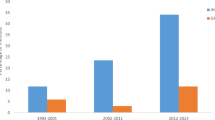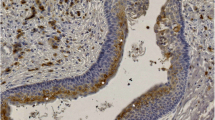Abstract
Aims
The aim of this study was to compare the clinical and demographic features of 62 patients presenting sporadic odontogenic keratocysts (OKCs) or OKCs associated with nevoid basal cell carcinoma syndrome (NBCCS). In conjunction with this, we also evaluated the immunohistochemical expression of Shh, Ptch1, Ptch2, Smo, Gli1, Gli2 and Gli3 proteins in 86 OKCs. By doing this, we add to the understanding of the biology of this type of lesion, providing tools that will help facilitate the early diagnosis of NBCCS in those patients where the first manifestation is that of OKCs.
Methods
This is a retrospective study; patients were classified into two groups: group 1 which consisted of those who were not affected by NBCCS (49 patients and 57 OKCs) and group 2 which consisted of those who were diagnosed with NBCCS (13 patients and 29 OKCs). The clinical and demographic features were studied and the immunohistochemical expression of Sonic Hedgehog proteins (Shh, Ptch1, Ptch2, Smo, Gli1, Gli2, and Gli3) was analyzed in all samples.
Results
There was an increase in the expression of three proteins in the syndromic OKC, when compared to that of sporadic cysts. Shh and Gli1 showed higher cytoplasmic expression, while Smo revealed stronger nuclear and cytoplasmic expressions.
Conclusion and clinical relevance
Our findings suggest that the expression patterns of important Shh pathway proteins can represent valuable markers for early diagnosis of NBCCS-associated OKCs, as the major criterion for the diagnosis of NBCCS is currently based on the late appearance of basal cellular carcinomas. Thus, standardizing a new diagnostic tool for diagnosis of NBCCS could be of great importance in the identification of therapeutic targets. We therefore suggest, as based on our findings, that OKCs showing high expression of Shh, Smo, and Gli1 are potentially associated with NBCCS.

Similar content being viewed by others
References
Boffano P, Ruga E, Gallesio C (2010) Keratocystic odontogenic tumor (odontogenic keratocyst): preliminary retrospective review of epidemiologic, clinical, and radiologic features of 261 lesions from University of Turin. J Oral Maxillofac Surg 68:2994–2999
Barnes L, Eveson JW, Reichart P, Sidransky D (2005) Pathology and genetics of head and neck Tumours. WHO Classif Tumour. IARC PRESS, Lyon
Wright JM, Vered M (2017) Update from the 4th edition of the World Health Organization classification of head and neck tumours: odontogenic and maxillofacial bone tumors. Head Neck Pathol 11:68–77
Friedrich RE (2007) Diagnosis and treatment of patients with nevoid basal cell carcinoma syndrome [Gorlin-Goltz syndrome (GGS)]. Anticancer Res 27:1783–1787
Manfredi M, Vescovi P, Bonanini M, Porter S (2004) Nevoid basal cell carcinoma syndrome: a review of the literature. Int J Oral Maxillofac Surg 33:117–124
Yagyuu T, Kirita T, Sasahira T, Moriwaka Y, Yamamoto K, Kuniyasu H (2008) Recurrence of keratocystic odontogenic tumor: clinicopathological features and immunohistochemical study of the Hedgehog signaling pathway. Pathobiology 75:171–176
Bitar GJ, Herman CK, Dahman MI, Hoard MA (2002) Basal cell nevus syndrome: guidelines for early detection. Am Fam Physician 65:2501–2504
Ortega Garcia De Amezaga A, Gracia Arregui O, Zepeda Nuño S, Acha Sagredo A, Aguirre Urizar JM (2008) Gorlin-Goltz syndrome: clinicopathologic aspects. Med Oral Patol Oral Cir Bucal 13:E338–E343
Bree AF, Shah MR (2011) Consensus statement from the first international colloquium on basal cell nevus syndrome (BCNS). Am J Med Genet A 155A:2091–2097
Hardcastle Z, Mo R, Hui CC, Sharpe PT (1998) The Shh signalling pathway in tooth development: defects in Gli2 and Gli3 mutants. Development 125:2803–2811
Adolphe C, Narang M, Ellis T, Wicking C, Kaur P, Wainwright B (2004) An in vivo comparative study of sonic, desert and Indian hedgehog reveals that hedgehog pathway activity regulates epidermal stem cell homeostasis. Development 131:5009–5019
Evangelista M, Tian H, de Sauvage FJ (2006) The hedgehog signaling pathway in cancer. Clin Cancer Res 12:5924–5928
Chari NS, McDonnell TJ (2007) The sonic hedgehog signalling network in development and neoplasia. Adv Anat Pathol 14:344–352
Riobo NA, Lu K, Emerson CP Jr (2006) Hedgehog signal transduction: signal integration and cross talk in development and cancer. Cell Cycle 5:1612–1615
Lo Muzio L (2008) Nevoid basal cell carcinoma syndrome (Gorlin syndrome). Orphanet J Rare Dis 3:32
Bhargava D, Deshpande A, Pogrel MA (2012) Keratocystic odontogenic tumour (KCOT)—a cyst to a tumour. Oral Maxillofac Surg 16:163–170
Zhang H, Ping XL, Lee PK, Wu XL, Yao YJ, Zhang MJ, Silvers DN, Ratner D, Malhotra R, Peacocke M, Tsou HC (2001) Role of PTCH and p53 genes in early-onset basal cell carcinoma. Am J Pathol 158:381–385
Vered M, Peleg O, Taicher SBA (2009) The immunoprofile of odontogenic keratocyst (keratocystic odontogenic tumor) that includes expression of PTCH, SMO, GLI-1 and bcl-2 is similar to ameloblastoma but different from odontogenic cysts. J Oral Pathol Med 38:597–604
Gonzáles-Alva P, Tanaka A, Oku Y, Yoshizawa D, Itoh S, Sakashita H, Ide F, Tajima Y, Kusama K (2008) Keratocystic odontogenic tumours: a retrospective study of 183 cases. J Oral Sci 50:205–212
Ge X, Lyu P, Gu Y, Li L, Li J, Wang Y, Zhang L, Fu C, Cao Z (2015) Sonic hedgehog stimulates glycolysis and proliferation of breast cancer cells: modulation of PFKFB3 activation. Biochem Biophys Res Commun 464:862–868
Ohki K, Kumamoto H, Ichinohasama R, Sato T, Takahashi N, Ooya K (2004) PTC gene mutations and expression of SHH, PTC, SMO, and GLI-1 in odontogenic keratocysts. Int J Oral Maxillofac Surg 33:584–592
Rui Z, Li-Ying P, Jia-Fei Q, Ying-Ying H, Feng C, Tie-Jun L (2014) Smoothened gene alterations in keratocystic odontogenic tumors. Head Face Med 10:36
Ruiz I, Altaba A, Sánchez P, Dahmane N, Altaba AI, Sánchez P, Dahmane N (2002) Gli and hedgehog in cancer: tumours, embryos and stem cells. Nat Rev Cancer 2:361–372
Myoung H, Hong SP, Hong SD, Lee JI, Lim CY, Choung PH, Lee JH, Choi JY, Seo BM, Kim MJ (2001) Odontogenic keratocyst: review of 256 cases for recurrence and clinicopathologic parameters. Oral Surg Oral Med Oral Pathol Oral Radiol Endod 91:328–333
MacDonald-Jankowski DS (2011) Keratocystic odontogenis tumour: systematic review. Dentomaxillofac Radiol 40:1–23
Gurgel CA, Buim ME, Carvalho KC, Sales CB, Reis MG, de Suoza RO, de Faro Valverde L, de Azevedo RA, Dos Santos JN, Soares FARE (2014) Transcriptional profiles of SHH pathway genes in keratocystic odontogenic tumour and ameloblastoma. J Oral Pathol Med 43:619–626
Evans DG, Farndon PA, Burnell LD, Gattamaneni HR, Birch JM (1991) The incidence of Gorlin syndrome in 173 consecutive cases of medulloblastoma. Br J Cancer 64:959–961
Wicking C, Smyth I, Bale A (1999) The hedgehog signalling pathway in tumorigenesis and development. Oncogene 18:7844–7851
Daya-Grosjean L, Couvé-Privat S (2005) Sonic hedgehog signalling in basal cell carcinomas. Cancer Lett 225:181–192
Acknowledgments
The authors would like to thank the São Paulo State Research Foundation (FAPESP) and the Organization for the Improvement of People in Higher Education (CAPES).
Funding
This study was funded by the São Paulo Research Foundation (FAPESP))and the Organization for the Improvement of People in Higher Education (CAPES).
Author information
Authors and Affiliations
Corresponding author
Ethics declarations
Conflict of interest
The authors declare that they have no conflict of interest.
Ethical approval
All procedures performed in studies involving human participants were in accordance with the ethical standards of the institutional and/or national research committee and with the 1964 Helsinki declaration and its later amendments or comparable ethical standards.
Informed consent
Informed consent was obtained from all individual participants included in the study.
Rights and permissions
About this article
Cite this article
Hoyos Cadavid, A.M., Kaminagakura, E., Rodrigues, M.F.S.D. et al. Immunohistochemical evaluation of Sonic Hedgehog signaling pathway proteins (Shh, Ptch1, Ptch2, Smo, Gli1, Gli2, and Gli3) in sporadic and syndromic odontogenic keratocysts. Clin Oral Invest 23, 153–159 (2019). https://doi.org/10.1007/s00784-018-2421-2
Received:
Accepted:
Published:
Issue Date:
DOI: https://doi.org/10.1007/s00784-018-2421-2




